‘Groundcover’ plants, or plants that grow low to the ground (think about 1 ½ feet tall), are the professional, low maintenance way of not only tying in design goals, but also keeping the weeds at bay. When groundcovers are on the job, weed seeds don’t see the light of day. We also love ground covers as they offer a plethora of heights, color and texture. This blog explores some Plant Sale groundcovers that we highly recommend for your garden because we’ve grown them ourselves.
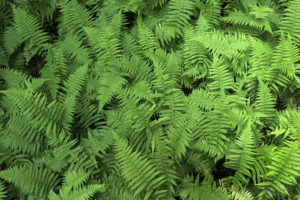
Sweeps of ferns in the groundcover layer
Ceratostigma plumbaginoides, Blue leadwort (full sun to part shade): Blue leadwort is a beautiful perennial that reaches about one foot tall. It blooms August through September, with flowers of deep blue that brighten the garden and pair beautifully with the yellows of early autumn. This plant does a wonderful job outcompeting weeds since its tough, wiry roots form a dense mat. It can even tolerate a wide range of soil types, though it doesn’t love wet soil.
Epimedium grandiflorum ‘Lilafee’, Barrenwort (part shade to shade): Barrenwort grows to about one foot in height and is a wonderful mat forming groundcover that brings a delicate look to the garden. The variety ‘Lilafree’ turns a rosy copper in the fall and persists through the winter, adding another season of interest. It also has lovely, airy purple flowers that bloom in March to early May, but the texture of their leaves will continue to add interest to the garden even after the blossoms fade.
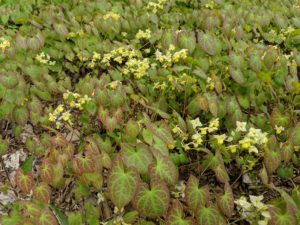
Epimedium sp., Barrenwort
Geranium maculatum, Spotted geranium (sun to part shade): Spotted geranium is a tough, native perennial that stands up to most garden conditions. Resistant to deer and rabbits, it can tolerate drought and attracts butterflies when it blooms in April to May. It grows to about two feet tall and appreciates a little shade during the hottest part of the summer. The foliage might fade a bit after flowering, but can be sheared back so that it will flush new growth and bring texture to the summer garden.
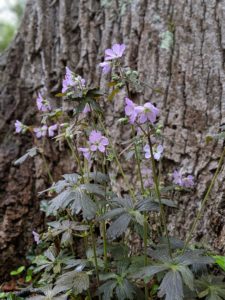
Geranium maculatum ‘Espresso’, Spotted Geranium ‘Espresso’
Heuchera villosa ‘Caramel’, Coral bells ‘Caramel’ (part shade): The beautiful caramel colored leaves of this native perennial will stop you in your tracks and add interest to any garden. Coral bells bloom in June and July, but the real draw is the color and texture of this plant. Deer and rabbit resistant, this plant will suppress weeds and brighten up a part shade garden.
Packera (Senecio) aurea, Golden groundsel (part shade): One of our very favorite native groundcovers, golden groundsel is partially evergreen in our area. Their rounded leaves will persist in the garden throughout the season and do an excellent job keeping out the weeds. In April, it will send up spires of blossoms that begin as deep, purple buds that open to starry, yellow flowers. There are few more cheerful sights for the spring garden. This plant reaches about two and a half feet in height when flowering, will tolerate moist soil and attracts butterflies.
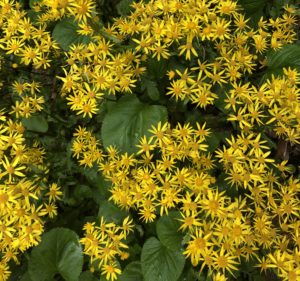
Senecio (Packera) aurea, golden groundsel
Sisyrinchium angustifolium ‘Suwannee,’ Stout blue-eyed grass (sun to part shade): This versatile native plant has a secret. It looks like a grass until it bursts into flower, with star-shaped clear blue blossoms that glow in the groundcover level of the garden. Stout blue-eye grass may look delicate, but it’s a tough, hardy plant that is deer and rabbit resistant and can tolerate both wet and dry soil. It grows to about a foot high when in flower and can be divided every three years to expand the planting.
Stachys byzantina ‘Silver Carpet,’ Lamb’s ear (sun): If you like soft silvers and softer textures in the garden, look no further than lamb’s ear ‘Silver Carpet’. This plant will blanket the ground with fuzzy textured silver gray leaves. Unlike many other Stachys, ‘Silver Carpet’ doesn’t flower, which is a benefit since other Stachys leaves decline following flowering. Highly deer resistant, lamb’s ear can also withstand drought, rocky soil and pollution. If you have a tricky spot in your garden, this might just be the plant for you!
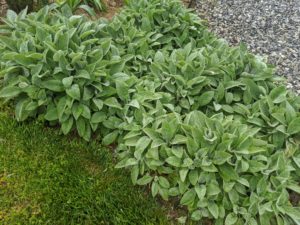
Stachys byzantina, Lamb’s ear
This is only a few of the great groundcovers we are offering this year at the Tyler Plant Sale. The best way to utilize these plants in the garden is to mass them around your taller perennials in areas where they can do their job of covering the ground to suppress weeds, and where they will play off your other plantings. Groundcovers are a fantastic way to introduce more flowers, colors and textures to an existing or newly established garden…all while reducing the work you need to put into weeding. As always, consider your site, garden goals and specific requirements when making your plant selection. Adding a few of these wonderful plants will be sure to add depth and interest to your yard and make your life as a gardener easier!
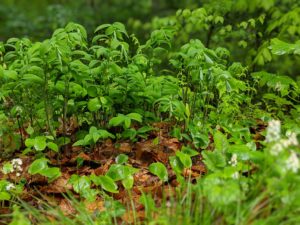
Polygonatum sp. Solomon’s Seal
Other recommendations —
Under trees:
- Yellow Barrenwort, Epimedium x versicolor ‘Sulphureum’
- Wild Wood Aster, Eurybia (Aster) divaricata — native
- Sweet woodruff, Galium odoratum
- Spotted Geranium, Geranium maculatum — native
- American alumroot, Heuchera americana ‘Dale’s Strain’ — native
- Woodland phlox, Phlox divaricata ‘Blue Moon’ — native
- Allegheny pachysandra, Pachysandra procumbens — native
Sunny Borders
- Stonecrop, Sedum acre
- Stonecrop, Sedum ternatum ‘Larinem Park’ — native
- Stonecrop, Sedum dasyphyllum
- Carpet bugle, Ajuga reptans ‘Chocolate Chip’
- Catmint, Nepeta x faassenii (racemosa) ‘Junior Walker’
- Moss phlox, Phlox subulata — native
- Pennsylvania sedge, Carex pennsylvanica — native and shade tolerant
Evergreen Groundcovers (with the exception of extreme cold winters)
- Allegheny pachysandra, Pachysandra procumbens — native
- Christmas fern, Polystichum acrostichoides — native
- Bear’s foot hellebore, Helleborus foetidus
- Corsican hellebore, Helleborus argutifolius






